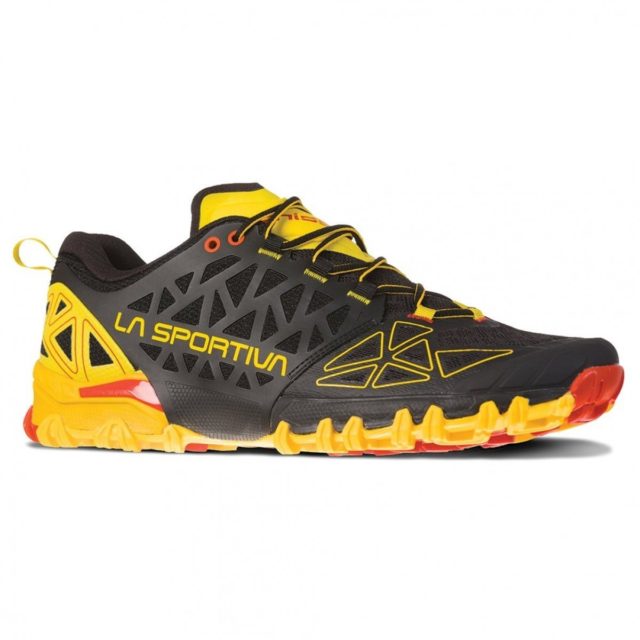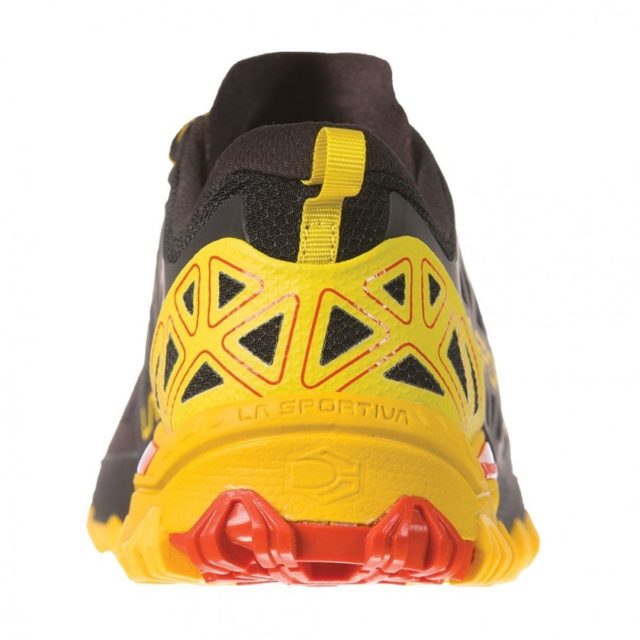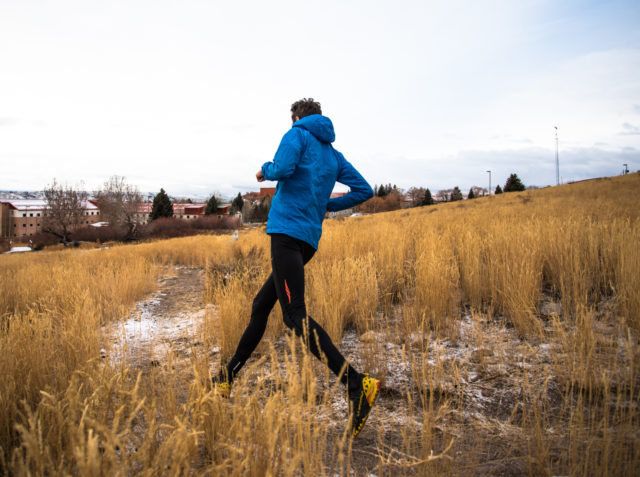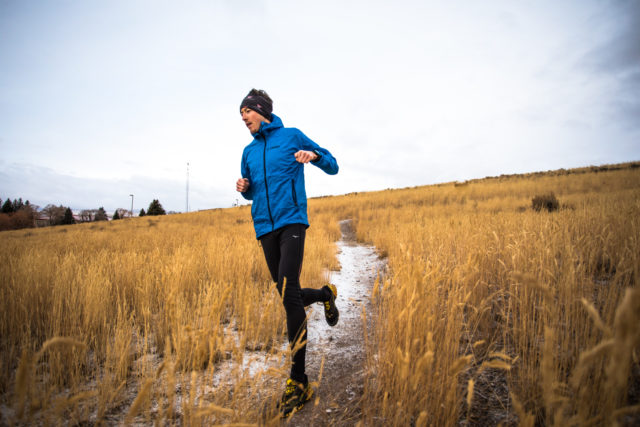La Sportiva Bushido II
Test Locations: Gunnison, Colorado; Sequoia, Kings Canyon, and Yosemite National parks, CA
Test Duration: 80 Miles
Stated Heel-to-Toe Drop: 6.0 mm
Stack Height: 19 mm (heel) / 13 mm (toe)
Stated Features:
- Open engineered mesh construction to maximize breathability and support
- Slip-on construction wraps your foot like a sock
- Updated heel design for increased comfort and fit
- Upper: AirMesh/Thermal adhesive microfiber/High frequency welded ripstop /TPU toe cap
- Midsole: 4mm LaSpEVA/ Compression molded MEMlex
- 1.5mm dual-density compressed EVA rock guard (forefoot), TPU STB inserts
- Outsole: Dual-density FriXion XT 2.0 V-Groove2 with Impact Brake System
- Last: Racing Lite Ergo (Performance Fit)
MSRP: $140.00
Size Tested: US Men’s 11.5 / EU 45
Stated Weight per Shoe (US Men’s Size 9): 298 grams / 10.5 oz
Reviewer: 6’1″ , 145 lbs

Intro
La Sportiva’s running shoes stay true to the brand’s mission to provide “technical products to explore the outdoors.” As a general rule, their shoes tend to be durable, close fitting, and protective, designed to keep you moving fast on rough terrain. The Bushido II is no exception. Like the original version of the shoe, it’s intended to give you maximum protection on mountainous, rocky terrain. I put a ton of hiking miles on the original version of the Bushido last summer, and agreed with Sportiva’s assessment that it was an extremely protective and stable shoe. But I also found it to be a little too stiff and unforgiving to feel natural while running.
The second iteration of the shoe has slightly softer cushioning and an updated heel cup and tongue to improve comfort and midsole flexibility. So do these updates give the Bushido II a more forgiving fit and ride than its predecessor? After about 75 miles of running, hiking, and scrambling in the Bushido II, I’ve found that it is more versatile than the original Bushido, but it still has some interesting quirks.
Previous Versions
As I mentioned above, the Bushido was my go-to hiking shoe last year. It was burly enough to hold up to off-trail scrambling, stable enough to wear while hiking with a heavy pack, and light enough to feel nimble and precise on technical terrain. With that said, all those protective / durable / supportive features meant that the Bushido felt extremely stiff. The shoe softened up somewhat after about 50 miles of break-in, but the lack of flexibility still made it feel clumsy when I did run in it.
The Bushido II has many of the same features as the original, but La Sportiva made a few changes that, in my opinion, greatly increase the versatility of the shoe. The first change I noticed when I took the Bushido II’s out of the box was that the hard plastic midfoot wrap of the original Bushido was gone. La Sportiva also claims that the Bushido II has softer cushioning and a “better” fit than the original. It’s still a pretty firm midsole, but I did notice that the Bushido II felt slightly softer than its predecessor.
Fit
We always stress the importance of trying on shoes in person before buying them, but that’s especially true for the Bushido II. La Sportiva is an Italian brand, so they use European sizing for all of their shoes. For whatever reason, their conversion to US sizing seems to be slightly different than other brands, resulting in shoes that consistently run a half- to a full-US size small. This definitely holds true for the Bushido II, in my experience. I’m a US 11.5 in virtually every other brand, but the 11.5 Bushido II felt pretty tight. If you do order the Bushido II (or any other La Sportiva) online, I’d recommend sizing up at least a half size from your normal US size.

Sizing notes aside, the Bushido II has a precise, secure fit. The heel cup seems slightly lower than other shoes I’ve run in, but still holds my heel securely thanks to a stout heel counter. The Bushido II has a gusseted tongue similar to that found in the Salomon S-Lab Sense series. The sides of the tongue are anchored to the footbed with a stretchy elastic material, so the midfoot of the shoe really feels like it hugs the foot before even tightening the laces. The forefoot is low volume to the point where I can feel the upper against the tops of my toes when wearing the shoe. It’s also fairly narrow even compared to the La Sportiva Lycan, which isn’t a particularly wide shoe.

Weight
The Bushido II definitely prioritizes protection and stability over weight, but it’s still not an extremely heavy shoe. For reference, here’s how the Bushido II’s stated weight compares to other shoes with a similar feature set and intended purpose. All weights are based on a US men’s size 9:
275 g / 10.0 oz — Inov-8 Roclite G 275
298 g / 10.5 oz — Altra Timp 1.5
298 g / 10.5 oz — La Sportiva Bushido II
303 g / 10.7 oz — Salomon X Alpine Pro
309 g / 10.9 oz — Brooks Cascadia 14
312 g / 11.0 oz — Arc’Teryx Norvan LD
On paper, the Bushido II weighs the same as the Altra Timp 1.5. I’ve spent a lot of time in both shoes, and I find that the Bushido II feels a little heavier on the foot. I think this is mostly due to the excellent flexibility of the Timp and the relative stiffness of the Bushido II. Either way, the Bushido II’s slightly heavy weight isn’t a big problem, but it is noticeable on trail. With that said, it’s lighter than most other options that offer similar amounts of protection and traction from other brands.
Weight (and Comparisons)
The Bushido II definitely prioritizes protection and stability over weight, but it’s still not an extremely heavy shoe. For reference, here’s how the Bushido II’s stated weight compares to other shoes with a similar feature set and intended purpose. All weights are based on a US men’s size 9:
275g / 10.0oz – Inov-8 Roclite G 275
298g / 10.5oz – Altra Timp 1.5
298g / 10.5oz – La Sportiva Bushido II
303g / 10.7oz – Salomon X Alpine Pro
309g / 10.9oz – Brooks Cascadia 14
312 / 11.0 oz – Arc’Teryx Norvan LD
On paper, the Bushido II weighs the same as the Altra Timp 1.5. I’ve spent a lot of time in both shoes, and I find that the Bushido II feels a little heavier on the foot. I think this is mostly due to the excellent flexibility of the Timp and the relative stiffness of the Bushido II. Either way, the Bushido II’s slightly heavy weight isn’t a big problem, but it is noticeable on trail. With that said, it’s lighter than most other options that offer similar amounts of protection and traction from other brands.
Upper
The Bushido’s upper consists of a combination of breathable “AirMesh” and synthetic overlays to provide support and durability. It’s also got a reinforced TPU rubber toecap to protect against inevitable rock-kicking. The outside of the heel cup has an additional rubberized overlay for added support and protection. As I touched on earlier, the sides of the tongue are attached to the insole with an elastic material that hugs the midfoot when you put the shoe on.
One notable change from the original version of the shoe is the removal of the hard plastic midfoot wrap. The original Bushido had a plastic overlay that wrapped from the side of the midsole most of the way up to the tongue in the midfoot area. While this helped hold the foot securely, it also contributed to the stiff, somewhat uncomfortable fit of the shoe (again, at least for me). The Bushido II does away with the hard plastic, replacing it with a more traditional flexible synthetic material. This helps improve the overall comfort of the shoe for me without sacrificing any precision in the fit. La Sportiva has also added a little extra cushioning to the top of the tongue, which again improves comfort by protecting / cushioning the top of your feet from the laces.

The AirMesh upper breathes well, as advertised. I haven’t had any problems with excessively hot feet in the shoe, even when I’ve worn it in temperatures up to 90° F / 32°C. The upper also drains well after creek crossings — the shoe doesn’t feel overly squishy and wet for more than a few steps after exiting the creek. With that said, the rubberized overlay on top of the newly added tongue cushioning makes the tongue dry much more slowly than the rest of the shoe. I’ve had it stay wet for several hours after crossing a creek, even though the rest of the shoe was completely dry. It’s not a major performance issue, but it can be a little annoying if you hate having wet feet.
Midsole
The midsole is one of the main parts of the Bushido II that actually feels different from the original version of the shoe. It’s still no soft / pillowy Hoka, but the cushioning does feel slightly softer than it did in the previous version. The Bushido II’s midsole has four components: LaSpEVA, Compression-molded MEMlex, a compressed EVA rock guard in the forefoot, and TPU stability inserts. Are you getting the feeling that La Sportiva likes fancy-sounding, extremely uninformative technology terms? Yeah, me too. I’ll do my best to translate:
For starters, LaSpEVA and Compression-molded MEMlex are La Sportiva’s two primary midsole foam compounds. MEMlex is stiffer, while LaSpEVA is slightly softer and offers more cushioning. The Bushido II has a 4 mm layer of LaSpEVA on top of a layer of MEMlex. The original Bushido had a full MEMlex midsole, so the big change here is the addition of the softer, more forgiving LaSpEVA layer.
The compressed EVA forefoot rock guard is just a thin, stiff layer on the bottom of the midsole in the forefoot of the shoe designed to keep sharp rocks from poking through. Finally, the TPU stability inserts are small, hard plastic bars in the middle of the midsole directly under the midfoot that provide a bit of added stability and support to control overpronation.
In simpler terms, the Bushido II has a two-layer midsole with a little more & softer cushion than the first version, a rock plate in the forefoot, and moderate pronation control. MEMlex, TPU, and LaSP-whatever aside, I’ve found the Bushido II’s midsole to be firm and not super flexible, but still more comfortable than the first version of the shoe. It’s still a much more rigid shoe than I’m used to, but I do notice and appreciate the added layer of softer midsole foam. It helps the shoe feel less stiff and awkward than the original Bushido, especially once it’s broken in a little.
As far as rock protection goes, the combined full rubber outsole and forefoot rock plate do a great job of protecting against sharp objects. You definitely lose a little trail feel from all this protection, but it’s nice to have on extremely technical terrain.
I’m used to running in neutral shoes with no pronation control whatsoever, so the TPU stability inserts took some getting used to. With that said, the amount of pronation control they offer is minor enough that it didn’t totally throw off my stride. I like neutral shoes to begin with so this was a pro for me, but if you want a serious pronation control shoe, I’m not convinced that the Bushido II will cut it.
Outsole
The Bushido II uses La Sportiva’s FriXion XT rubber (also called FriXion Red in some areas) in the outsole, which is designed to strike a balance between grip and durability. The outsole is separated into two parts, with harder rubber along the sides for added durability and softer rubber in the middle for better grip.
The lugs are moderately sized: bigger than those on shoes like the Altra Superior 4.0 or the La Sportiva Lycan, but much lower-profile than a mud shoe like the Altra King MT or the La Sportiva Mutant. The Bushido II’s outsole also has the “Impact Brake System” found on pretty much all of La Sportiva’s trail shoes. Basically, this means that it’s got adjacent lugs that slant in opposite directions. La Sportiva claims this contributes to both shock absorption and traction on steep terrain. I’ve never been able to perceive a huge difference in either of these areas relative to other shoes / brands, but it doesn’t hurt the shoe’s performance at all in my experience.

Weird technologies aside, I’ve been very impressed with the Bushido II’s outsole so far. The shoe grips extremely well on rocks, roots, hard-packed trails, and most everything in between. Like pretty much every non-mud shoe, it slips a little in deep mud or sand, but that’s to be expected of an all-round shoe like the Bushido II. The combination of hard and soft rubber on the outsole seems to work especially well on granite slabs, which I’ve appreciated while wearing the shoe for runs and hikes in Yosemite and Sequoia / Kings Canyon National Parks.
On Trail
From the beginning, my main question about the Bushido II was whether or not it managed to feel more comfortable and natural on trail than the original version of the shoe. The answer? Sort of.
After about 75 miles in the shoe, I’ve come to appreciate the stiff, precise fit and ride on certain terrain, but I still don’t love the shoe for moderate to non-technical trails. Most of my miles in the Bushido II have been on the trails of Yosemite and Sequoia / Kings Canyon National Parks, which have everything from sand to scree fields and everything in between. On rocky, technical trails, the Bushido II feels like it’s in its element. I usually don’t like extremely built-up, protective shoes, but I’ve appreciated the extremely locked-down fit and excellent stability of this shoe on many of my runs in the Sierras.
The close fit makes the shoe feel surprisingly nimble for rock hopping and steep climbing / descending, considering it’s somewhat heavy. It also holds your foot securely on off-camber terrain, making it ideal for the granite slabs that are common on trails in the Sierra Nevada Mountains. The relatively stiff, inflexible midsole also contributes to this by keeping the Bushido II from feeling soft or sloppy on uneven terrain. In addition, the shoe does a great job of protecting your feet from all varieties of trail obstacles. I’ve stubbed toes and landed hard on numerous sharp rocks while running in the Bushido II, and it’s done a better job of protecting my feet than any other shoe I’ve run in recently. This combination of precision and protection are pretty confidence inspiring on technical terrain. It also makes the Bushido II an excellent option for scrambling.
Unfortunately, many of the features that make this shoe work well on technical terrain also make it much less ideal for pretty much everything else. The Bushido II does have a bit more cushioning and flexibility than the original version of the shoe, but it remains an extremely stiff shoe. This rigidity messes with my stride as soon as I hit non-technical trails, completely eliminating the smooth transition of a softer shoe like the Altra Timp 1.5. The ultimate irony of the Bushido II is that for me, it made terrain that should be smooth and efficient feel jarring and clumsy.
Another issue I ran into is that the narrow, precise fit of the Bushido II became downright uncomfortable after a few hours in the shoe. For my feet (which, by the way, are fairly narrow / low volume), I couldn’t run more than an hour or two without my feet starting to feel cramped. Going up a half size might help this issue, but the narrowness would probably still discourage me from choosing the Bushido II for runs longer than two hours.
Durability
Durability was a definite strong point for the original Bushido, and the same seems to hold true for the Bushido II. While I’ve only put 75 miles on the shoes thus far, those miles have been on pretty rough terrain, including a significant amount of off-trail. In spite of that, the uppers look pretty much the same as they did from day one. The outsole looks lightly worn, but probably still has several hundred miles of life left in it. Finally, the midsole doesn’t seem to have compressed or packed out at all.
If anything, I expect the ride and fit of the shoe to improve with more miles as the shoe continues to break in. I got over 500 miles out of my pair of the Bushido I, including a significant amount of off-trail use. Even then, I only had to retire them because I ripped the toebox of one shoe open on a sharp rock. Based on how little they’ve worn so far, I expect the Bushido II’s to last just as long., I’ll post a durability update if I do run into any issues with the shoe down the road.
Who’s It For?
In my opinion, the Bushido II is designed with a pretty specific type of runner and terrain in mind. As I’ve said, this shoe is pretty awesome for uneven, technical, rocky terrain if you have fairly narrow feet. I personally wouldn’t wear it for longer runs, but I know plenty of people who use the Bushido II for long ultras and love them, so your mileage may vary (especially if you prefer stiffer, less-cushioned, narrower shoes). The stability inserts also make it a good option in the fairly limited market of pronation control trail shoes. If you have especially wide feet, run mostly on non-technical terrain, or like a neutral, flexible shoe, the Bushido II won’t be the best shoe for you.
But if you like a shoe that’s protective and stable on particularly rough terrain and don’t mind sacrificing a little comfort (plush cushioning & more accommodating fit), the Bushido II could be a worthwhile option.
Bottom Line
In spite of my complaints about the La Sportiva Bushido II on non-technical trails, I do enjoy running in the shoe on the right terrain. It feels much more secure and confidence inspiring than my other go-to shoes (Altra Timp 1.5, Altra Superior 4.0, La Sportiva Lycan) when the going gets truly technical. It’s worth noting that La Sportiva designed the Bushido II for “unbeatable performance and protection on technical terrain.” Like the previous version of the shoe, the Bushido II was never meant to be an easy trail cruiser shoe; it was designed to keep you moving confidently on mountainous terrain, and if it fits your foot, it does that job extremely well.




Gordon, very helpful review. Sounds like the Bushido II would be a good option for trail running in the Washington Cascades. Really appreciate your candor and objectivity.
Great review!
I was wondering if you tried them on the half dome by chance? I wonder how they performed on the steep granite…
What other brands have shoes in this technical terrain class in case Sportiva’s narrow last doesn’t fit wider feet? It sounds like its a hybrid of running/approach shoe
Hi Ethan,
The Bushido II does feel reminiscent of an approach shoe — It definitely has a little more room in the toe box than most approach shoes I’ve seen, but not much.
Re: wider shoes for technical terrain — You might check out the Altra King MT 2 (https://blisterreview.com/gear-reviews/running-shoes/altra-king-mt-2). Like all Altra shoes, it has a wider foot-shaped toe box, but it’s designed for loose / muddy / technical trails. The Topo Athletic Mtn Racer (https://blisterreview.com/gear-reviews/topo-athletic-mtn-racer) also holds its own on technical terrain and has a wider fit, although it doesn’t feel quite as secure as the Bushido II (at least not for my feet).
Hope that helps!
This is a great and accurate review. You are reinforcing some of my original thoughts